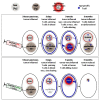Peptide-based anticancer vaccines: The making and unmaking of a T-cell graveyard
- PMID: 24073366
- PMCID: PMC3782014
- DOI: 10.4161/onci.24743
Peptide-based anticancer vaccines: The making and unmaking of a T-cell graveyard
Abstract
Poorly biodegradable, incomplete Freund's adjuvant (IFA)-based anticancer vaccines primed CD8+ T cells that did not localize to the tumor site but to the persisting, antigen-rich vaccination site, which became a T-cell graveyard. Short-lived, water-based formulations and the provision of immunostimulatory molecules overcame this issue, resulting in tumor suppression. Here, we discuss the implications of these findings for the development of therapeutic anticancer vaccines.
Keywords: T-cell deletion; T-cell dysfunction; T-cell trafficking; antigen persistence; immunotherapy; sequestration; vaccine depot.
Figures

References
-
- Rosenberg SA, Sherry RM, Morton KE, Scharfman WJ, Yang JC, Topalian SL, et al. Tumor progression can occur despite the induction of very high levels of self/tumor antigen-specific CD8+ T cells in patients with melanoma. J Immunol. 2005;175:6169–76. - PubMed
-
- Bonhoure F, Gaucheron J. Montanide ISA 51 VG as adjuvant for human vaccines. J Immunother. 2009;29:647–8.
Grants and funding
LinkOut - more resources
Full Text Sources
Other Literature Sources
Research Materials
